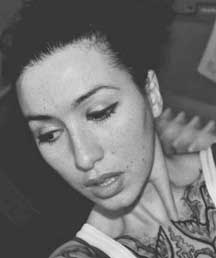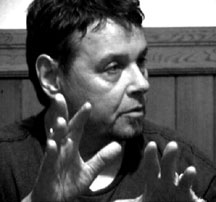Four Questions about Paratheatre
Frieda Roenisch interviews Antero Alli
September 11, 2006
1. How did your role as facilitator of paratheatrical rituals first come about?
My role as facilitator of paratheatrical rituals first came about in 1977 after participating in a six month group ritual experiment led by artist, David Rosenbloom. This process was inspired by Grotowski's paratheatre ideas from the film document of "Akropolis" and his book "Towards a Poor Theatre" while incorporating elements of Zazen standing mediation and its relationship with a highly intuitive approach to motivated movement. After this six-month experiment ended, I was the only one in that group motivated enough to continue developing the work we had started. Seeing as my theatrical background was in mime theatre, I began integrating those principles and techniques into Rosenbloom's approach. This gradual integration would eventually become the paratheatrical medium I practice today.
My role as ritual facilitator developed over many years of working with many different groups from all walks of life -- performers, actors, non-actors, martial artists, dancers -- all of whom inspired various adjustments and new developments in the infrastructure of this newly emerging medium. As a facilitator, I am always learning, always receptive to the situation at hand: those who are present, their talents and weaknesses, and unique movement signatures, all of which contribute to the distinct group animal of each paratheatre lab process.
2. Were there any socio-cultural factors that inspired you to commit to the rigorous creative/spiritual processes employed in paratheatrical rituals?
The precise socio-cultural factors that inspired me to commit to these rigorous creative/spiritual processes are a little mysterious to me. However, one factor stands out as a consistent resource and that is the value of positing an asocial intent at the start of any group paratheatre work. What is asocial ? A question worth asking over and over, again. Without an asocial intent, it is easy for our conditioned social responses, needs and obligations to develop the fabric of interpersonal bonding between participants. In social events, this can be a healthy and natural way for any group to meet, get along and do things together.
However, I have discovered that these very social bonds can also inhibit and frustrate the creative states of expressing our true feelings and spontaneous responses to internal and external stimuli. When a group becomes preoccupied with the masks and games we play to meet our social needs for friendship, courtship, belonging, approval, security, status and so forth, we can easily lose track of our verticality, those sources of energy above, within and below as a vertical plane or column; like a plumb line.
One way the asocial can be posited is by a conscious choice to redirect your attention off of yourself and off of each other and onto the space itself as a value. To move through the space of the actual setting in such a way as to continually relate to the space itself -- rather than the people or the things in the space -- cultivates a higher degree of receptivity and spatial awareness as a foundation for a kind of interaction that honors the space around others, rather than blindly interfering with and even violating that space. This sets up a tone of silent respect uncommon in normal socio-cultural relations and paves the way towards establishing a commitment to one's own vertical sources, rather than looking to others for the energy and guidance one has failed to find within.
3. Over the course of your extensive facillitation of paratheatrical rituals is it possible to describe some key ways in which such work can affect the identity of particpants?
The primary way in which this work affects the identity of participants is through an amplification of the existing conditions within themselves and the self-awareness for recognizing this internal landscape as a legitimate source of spiritual authority. Those who continue in this work tend to become more of what they have always been but perhaps with less resistance and more acceptance of their totality of weaknesses and strengths, brilliances and stupidities, talents and mediocrities. "The more you change, the more you stay the same." Those who cannot sustain commitment in this approach often withdraw in response to the daunting prospect of increasing their autonomy with greater self-responsibility.
4. In what ways did the making of 'Orphans of Delirium' go on to inform projects that you continued to create both as a director and paratheatrical lab facillitator?
'Orphans of Delirium' marked one of a series of significant turning points in the development of this medium. Through this project, we realized that we could actually develop and design rituals to serve very real processes of initiation that we were separately -- and as a group -- undergoing in our lives at the time. This proved invaluable in lieu of the utter lack of initiation rites offered by traditional religions, schools and modern society at large for those undergoing intense transformative experiences in their lives. The life-changing influences of this project have been evidenced over the two years following its execution in the individual lives of those who participated.
Since 'Orphans of Delirium' , I have approached the paratheatre work with an eye towards serving the needs of the greater community. Six months after 'Orphans of Delirium' we began the "Song as Vehicle" ritual lab towards the performance of a winter solstice ritual during the season when many people fail to find communion with traditional religious rituals. The following Spring (2005) we prepared a public ritual lament for those bearing the losses of loved ones with "Requiem For a Friend", featuring the epic prose work of the same name by poet Rainer Maria Rilke. Our next paratheatre project, "Ritual Actions", approaches the next winter solstice with a paratheatre performance of a 14th century Armenian choral work (2006). And that's where we stand today, September 11th, 2006.

Frieda Roenisch is an artist and performer who lives in England.
(click her image for her art portfolio)
other interviews with antero alli
ParaTheatrical ReSearch site map
